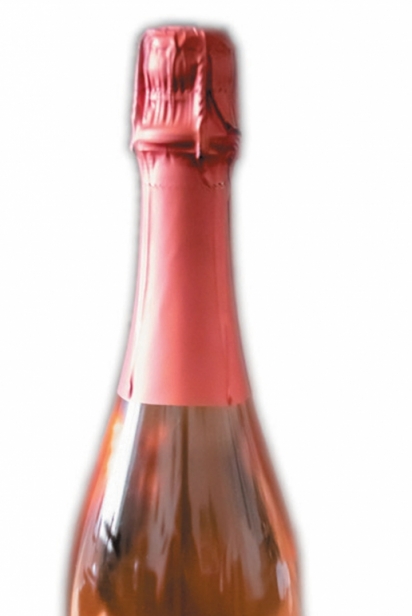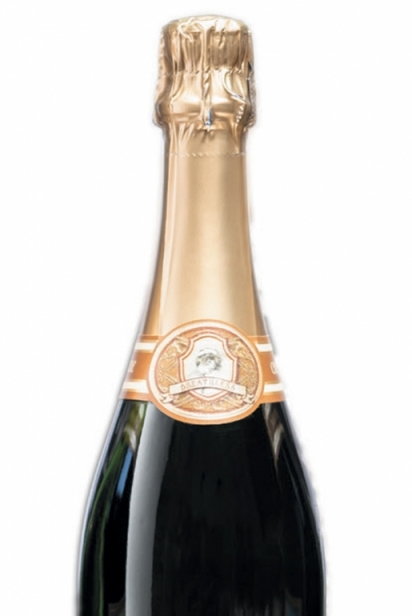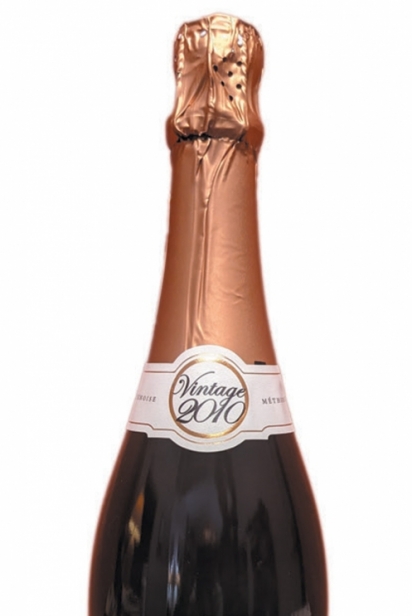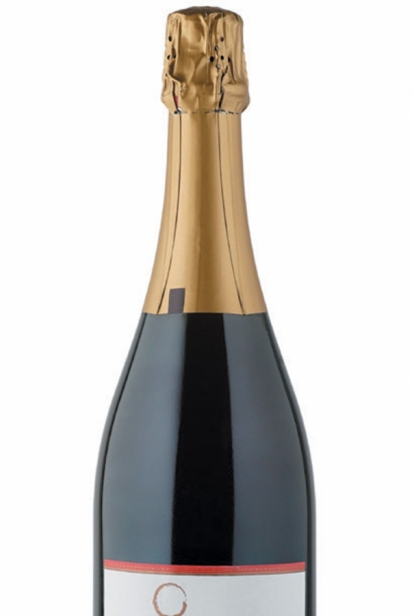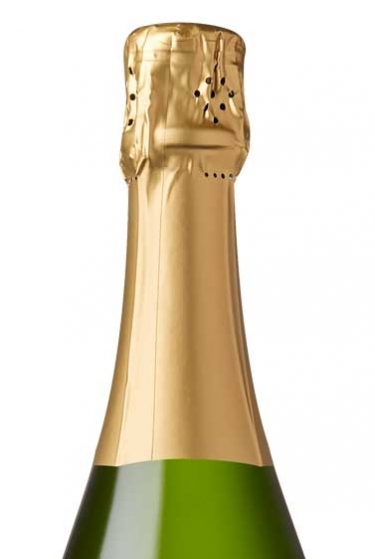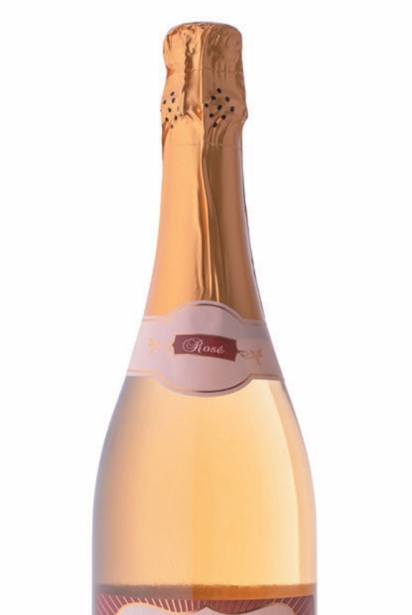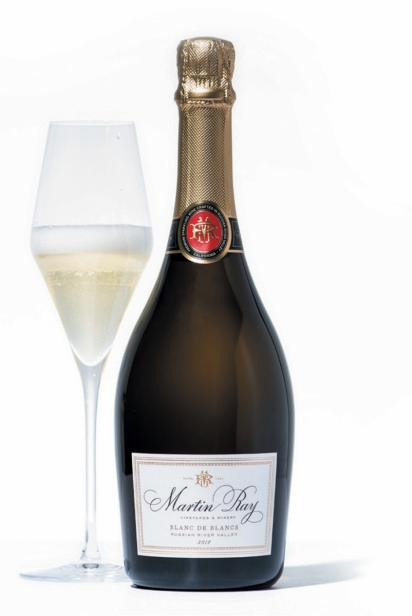Sparkling Surprises
Sonoma County is many things, not least stunningly picturesque, also vast, and with a diverse array of vistas and terrains. Boasting more than 1,700 square miles of total area, it ranges from dense forests to rocky mountaintops and, of course, lush and rolling vineyards.
One of Sonoma’s defining characteristics is proximity to the Pacific Ocean, which—along with diversity of altitudes and soil types—helps make most of the county very well-suited to growing grapes, Burgundian grape varietals in particular.
Sonoma’s 60,000 acres of vineyard are divided amongst 19 nested American Viticultural Areas (AVAs), well over half of them planted largely to Pinot Noir, Chardonnay, or both; These include some legendary Burgundian-producing areas such as the Russian River Valley, Los Carneros, the Petaluma Gap and the Sonoma Coast. And while the American appetite for Chardonnay and Pinot Noir may appear nearly boundless, these beautiful grapes—as well as others that favor growing in like climes—have a propensity to don the mask of bubbles and assume an alter ego in the form of sparkling wines. To that end, Sonoma is home to some huge names in sparkling wine, such as the historic Korbel Winery, Gloria Ferrer, J Vineyards and others.
Yet in addition to these big names in bubbles, there are many noteworthy small producers and dabblers within the realm who are making unique and fascinating contributions to the canon of Sonoma’s sparkling wine. Here is an examination of some of those endeavors. The list is by no means exhaustive, neither of producers nor of each producer’s wines, and the best way to discover Sonoma’s many sparkling surprises is, of course, to visit. That being said, perhaps the following will heighten your interest and increase your sense of urgency to do just that.
Bacigalupi Blanc de Noir 2017
The world of wine relies heavily upon French terminology, even when, as in this case and so many others, the origin of the producer lies elsewhere. Blanc de Noir, the counterpoint to Blanc de Blancs, essentially translates into “white from black” and is a designation used for sparkling wines that contain significant amounts of Pinot Noir—a red grape varietal commonly used to make sparkling wine. This style of wine has a great deal to offer, and is somewhat less common than many of the other designations that appear upon bottles of bubbly.
Bacigalupi is a family-owned winery just outside of Healdsburg with a profound history in sparkling wine. Adolf Heck had immigrated from Alsace-Lorraine, a disputed territory on the border of Germany and France, and managed the Imperial Wine Company in St. Louis before reestablishing Cook’s Imperial Champagne Cellars. Adolf’s son, Paul Heck, would go on to be part-owner of the historic Sonoma producer Korbel. Paul’s daughter, Pam, who spent much of her childhood doing cellar work at Korbel, would grow up and marry John Bacigalupi, whose parents Helen and Charles had founded Bacigalupi Vineyards. Today, John and Pam’s daughters, Katey and Nicole, comprise the third generation to serve at the family winery.
The 2017 Bacigalupi Blanc de Noir hails from the Russian River Valley and was limited to a mere 217 cases of production. While all but the most zealous pet-nat extremists rely upon dosage—and addition of still wine, sugars or both—to balance out their sparkling wines, Bacigalupi has done something extremely clever with theirs: In addition to small amounts of still Chardonnay and Pinot Noir, they’ve added locally raised honey from the Sonoma Bee Co. in place of more typical sources of sugar. The impact on the mouthfeel of the wine is noteworthy, as is the commitment to keeping things local (most sugar is not produced in the United States). And while it may be a stretch to call the wine hypoallergenic for its small amount of local honey, it’s no exaggeration at all to call it delicious.
Breathless Sparkling Pinot Munier 2018
Pinot Meunier is to traditional sparkling wines what Mourvedre is to Rhone blends; to some it is an afterthought, often left out, though to others it is an essential ingredient. And just as Mourvedre on its own in the hands of a talented winemaker can produce a beautiful, fascinating red wine, Pinot Meunier can be incredible either still or sparkling—the latter of which is the direction that our friends at Breathless took it in, and the result speaks for itself.
Breathless Sparkling Wines is the brainchild of three sisters, Sharon Cohn, Rebecca Faust, and Cynthia Faust, in honor of their mother, Martha Jane, “for all the breathless moments she created in our lives.” This women-owned brand is devoted wholly to the production of excellent bubbles, with more than a dozen takes on sparkling bearing their label, and is equally devoted to supporting local charities. Widely acclaimed and highly sought-after, winemaker Penny Gadd-Coster just completed her 37th harvest, and Breathless is a brand that ought to adorn every table in America.
The 2018 Breathless Pinot Meunier is wicked fun. Be careful removing the cork because those bubbles are begging to get out (one unnamed imbiber may or may not have shot himself in the neck with the cork while writing about this wine). The wine itself is gorgeous, a pale lemon hue with flavors and aromas of underripe stone fruit, subtle earthy cues and beautiful bready notes. With grapes sourced from the Russian River Valley and Los Carneros, it is 100% varietal and 100% delicious.
brick & mortar
Manchester Ridge Blanc de Blancs 2018
One of the best things a wine lover can do in Wine Country is to ask the locals where to go next. The person behind the tasting room bar almost always has a secret they’re willing to share with a pleasant customer. The same can be said for writing, and whilst constructing a list of small sparkling wine producers in Sonoma, the response to the question “who else should be included?” was, more often than not, brick & mortar wines, located in Healdsburg.
Committed to the world of sparkling wine and also to the planet, brick & mortar is part of the evolutionary movement of creative, forward-thinking winemaking taking place in Sonoma. Their name, all lowercase despite what Microsoft Word’s little red squiggly line has to say about it, is a nod to their minimalist approach to intervention. The winery is also a member of 1% for the Planet, contributing 1% of sales (not to be confused with profits) to global organizations that seek to tackle the world’s environmental threats. This is thus a wine for the palate and the planet all at once.
Manchester Ridge is a vineyard in Mendocino County that sits more than 2,000 feet above sea level, with cooling effects coming from the Pacific breezes and intense sunshine as a result of being largely above the cloud line. brick & mortar’s 2018 Blanc de Blancs from this source is a beautiful bottle of bubbles. Disgorged after nearly five years on the lees, the wine is developing nicely, with tart notes of stone fruit mixed with subtle floral and herbaceous qualities. The 2018 vintage was the inaugural release from this source, and it seems likely to become a favorite among brick & mortar’s growing throng of fans.
En Tirage
Blanc de Blancs Extra Brut 2010
Red wine with red meat, white wine with white meat, red wine in the cellar, white wine on the table, blah blah blah. One would think by now that the myriad—nay, countless—traditional rules about wine being, well, often downright wrong, would lead to more enlightened consumption, and yet the reality is that even experienced consumers are wont to fall back upon tradition (cue Tevye!) when they’re feeling a bit lazy. Sure, Napa Cab and Nebraska beef are in a marriage ordained by God, but have you ever encouraged that steak to commit adultery with a 30-year-old Kabinett? Divine. So while most of the wine being made in the world is consumed within a day or two of being purchased, Don Baum-hefner helps his customers out by aging his sparkling wines for a decade plus before release.
Until recently, Baumhefner was still selling his 1990 vintage extra brut sparkler to the public. His philosophy? Aside from patience, an acute understanding of what sparkling wine can be and an expectation that his wines meet that potential. And while the vast majority of sparkling wines receive significant dosage, Baumhefner drastically limits his to help improve their age-ability and keep them bone dry. For his wine to be “extra brut,” he adds only 4 grams of dosage, a small fraction of the norm, and allows extended time on yeast (in the case of the 2010, 11 years of it) to help provide balance in his wines.
Anyone who has ever tasted older bottles of sparkling wine know that time makes for smaller, less energetic bubbles and a realm of complexity that can only come from tertiary flavors, which only show themselves over lengthy periods of time. Sourced from Beckstoffer’s Las Amigas Vineyard in Los Carneros, the 2010 Blanc de Blancs extra brut is a blend of 80% Chardonnay and 20% Pinot Noir, left on the lees until January 2022. Even at a modest production of 420 cases, one can’t help but admire the incredible time and patience Baumhefner exhibits in his craft.
Harvest Moon
Sparkling Gewürztraminer 2021
It is difficult to overstate the joys of a great Gewürztraminer (seek out Mike and Nicol Duffy at Optima in Healdsburg if you’ve yet to try one). Such a complicated and underappreciated varietal, “Gewürz” can be utterly explosive upon the palate, manifesting itself in a startling array of flavors, textures and aromas. That few before now have thought to turn it into fizz is frankly a shame, but fortunately for the wine-loving world, Harvest Moon has shown a willingness to carbonate almost anything. From Pinot Noir to Zinfandel, their creativity seemingly knows no limits, and in the case of their Sparkling Gewürztraminer, well, they begin to formulate a compelling case that this may be the highest and best use of the varietal.
Winemaker Randy Pitts began making sparkling wines at Harvest Moon a decade ago to complement an already impressive array of varietals that included Zinfandel, Pinot Noir, Cabernet Sauvignon, Syrah, Sangiovese and, of course, Gewürztraminer. Plumbing the depths of innovation in the realm of sparkling wine, Harvest Moon is equally committed to sustainability and reducing their carbon footprint.
The 2021 Harvest Moon Sparkling Gewürztraminer is, for want of greater nuance, really freaking cool. From the nose, the varietal is revealed, telltale hints of clove and exotic spices flirting from the nostrils to the palate, where even the bubbles cannot disguise the body of the wine which is, among other things, varietally correct. Though sparkling Gewürz isn’t “a thing” in mainstream winemaking, most somms would quickly peg this wine by the varietal, and then ask “Hey, why aren’t more people doing this ?”
Keller Estate
Blanc de Blancs 2019
Situated southwest of Sonoma and roughly equidistant from the townships of Sonoma and Petaluma, Keller Estate reaps all the benefits of being located on the eastern side of the renowned Petaluma Gap: dense, heavy fog cover; intense afternoon winds; and startling shifts in diurnal range, all of which lead to thick-skinned, acid-driven fruits that can produce intensely flavorful wines.
But the Petaluma Gap’s unique viticultural microclimates were once more feared than revered by most of the winemaking world, and it took time and a special breed of neo-pioneers who were willing to gamble to realize the area’s tremendous potential. Among those pioneering types were Arturo and Deborah Keller, who appreciated the vistas of the area and preferred their wines sparkling; they planted Chardonnay in the mineral-rich soils with the contingency plan of making bubbles. Lo and behold, sometimes things work out. Today Keller Estate produces a variety of beautiful wines, not least this coveted expression of Blanc de Blancs.
The 2019 Keller Estate Blanc de Blancs is wonderful. A classically styled, traditional, easy-drinker, it’s as age-worthy as it is elegant. Light and refreshing upon the palate, begging for oysters on the half-shell, this wine is reminiscent of grower Champagne and worthy of any table. Tasted alongside a variety of other excellent Blanc de Blancs, it easily holds its own.
Larson Family Winery
Brut
N.V.
Land has myriad purposes, even in Wine Country, and over their five generations in the Los Carneros area the Larsons have explored many of them on their own little plot of paradise. From a dairy farm to the location of the largest rodeo in Northern California for nearly three decades beginning during Prohibition, they planted vineyards in 1978. After about 10 years, they opened their own winery and, after that, a tasting room. Hey, if people can evolve, then why can’t land?
Today, the Larson family continues to own and operate their family winery near the town of Sonoma, and encourage visitors to bring their own dogs to meet Ollie, Rosko, and Louie, the Larsons’ trio of Labradors. Among a diverse portfolio of wines that include Cabernet Sauvignon, Chardonnay, Tempranillo, Syrah, Malbec, Pinot Gris and more, bubbles have recently been added, to great effect.
Crafted from 55% Chardonnay and 45% Pinot Noir, the Larson Family Winery Brut bears no vintage designation yet was harvested in 2015 and disgorged in February 2020. Approaching nine years of age, the wine is developing nicely and offers some pleasant complexities and a palate full of pommaceous fruits with hints of stone fruit mingled amidst the bubbles. It’s a great way to kick off a wine tasting or an evening on the patio.
Martin Ray Vineyards & Winery
Brut Rosé
2018
“If it ain’t broke don’t fix it” is a pragmatic mantra, certainly, but it rarely leads to innovation. Though Martin Ray Vineyards and Winery have been successfully producing noteworthy wines since the 1940s, their foray into the world of what goes pop and fizz is a far more recent undertaking. Though Martin Ray himself was a lover of sparkling wine, the winery that bears his name marks 2018 as the inaugural release of their sparkling wine program, with Raemy Paterson at the helm.
Paterson describes the sparkling wine project as a labor of love, which helps explain the winery’s decision to keep the entire process in house rather than outsourcing some of the more difficult and tedious steps. Paterson admits that there was a steep learning curve, but posits that it was offset by the producer’s ability to maintain full control of the process and remain uncompromising in their approach. “I am absolutely delighted with the results,” says Paterson. She should be.
The 2018 Brut Rosé from Martin Ray flashes an electric pink hue that juxtaposes starkly alongside a dry, elegant wine with excited bubbles and beautiful notes of dried rose petal, baked bread and subtle strawberry erupting. After tirage the year following harvest, the wine sat on the lees for three years and was disgorged in the summer of 2022. A youthful wine, it will continue to age beautifully. “The endeavor has proven to be one of the most challenging and rewarding experiences in my career,” says Paterson, and while it’s great that she feels rewarded for her efforts, the consumer is the real beneficiary.
Woodenhead
Naturale
2019
When Nikolai Stez’s father fled the Russian and German armies during the Second World War, it was with thoughts of survival and little more. A stay in France tempted fate, and he nearly married the beautiful daughter of a vigneron, but France was too close to the enemy for Stez’s brother, who urged him farther west toward America. Thus, Nikolai Stez was born not in Reims, as he might have been, but in San Francisco. A year after his birth, his parents moved to the Russian River Valley, where he has remained ever since.
The success of the American wine scene can largely be summed up in the concepts of immigration and innovation, both of which are thematic at Woodenhead, where today Nikolai Stez is part-owner and makes the wine. From the standpoint of innovation, Stez is doing numerous things that many people simply aren’t. His limited dosage and commitment to making dry wine rings true with a handful of other sparkling producers, while his use of French Colombard—a varietal of which Stez estimates there may be as little as five acres in all of California—may be unique to California or even beyond. Stez imports his own yeast from biodynamic vineyards in Fleurie, a sub-region of France’s famed Beaujolais AOC. He’s also experimenting with vineyard practices and tirage. In short, Stez makes the wine his way, and it’s unlikely you’ll encounter another one much like it.
The 2019 Woodenhead Naturale is a bone-dry wine with beautiful, vibrant bubbles and a youthful nature. The complexities are fun; the wine ranges from tart citrus and notes of ginger to pom- maceous fruits and yeasty notes. 100% French Colombard and 100% Nikolai Stez, it’s a unique offering and one that any lover of sparkling wines should add to their short list.
The wine scene in Sonoma has never been livelier or more interesting, and the continuing emergence of sparkling wines is an exciting development.
It’s a mistake, really, that bubbles are so often seen only as a complement to celebration. Certainly, it’s brilliant to pop a cork when commemorating an important event, though upon closer examination perhaps we can all agree that Thursday evening sunsets, the completion of the workday and the release of a new episode of “Loki” are also significant enough occasions to warrant a sabrage. Few wines offer the diversity and crowd-pleasing capability of those that sparkle, pairing incredibly with diverse fare from around the world, and few wine regions in the world can compete with the quality and diversity of those being produced in Sonoma County.
While the above list constitutes only a sampling of that which can be viewed above, the massive entanglement of roots below the surface digs deep into the realm of what wine in all of its many iterations can be, and makes a significant contribution to what makes Sonoma such a special—sparkling—sort of place.
Mark Gudgel is the board president of the vin NEBRASKA Foundation and the author of The Rise of Napa Valley Wineries: How the Judgment of Paris put California Wine on the Map, an excerpt from which you can savor in this issue. Mark lives in Omaha with his wife, Sonja, and their children, Titus and Zooey.



